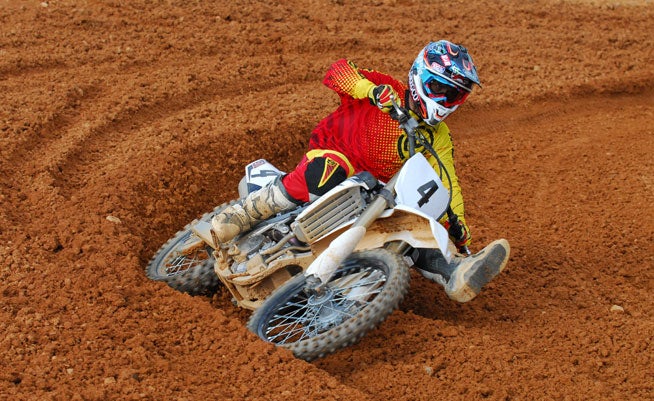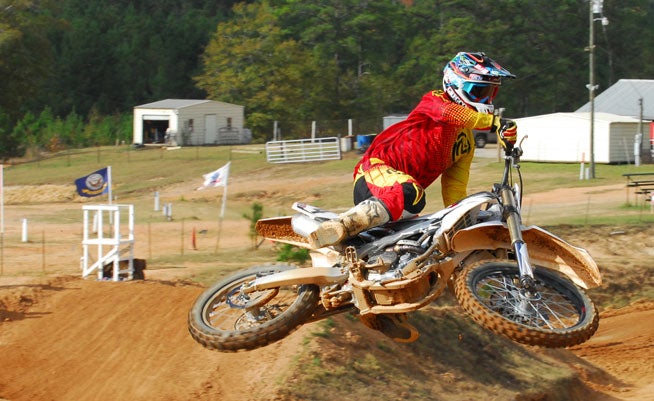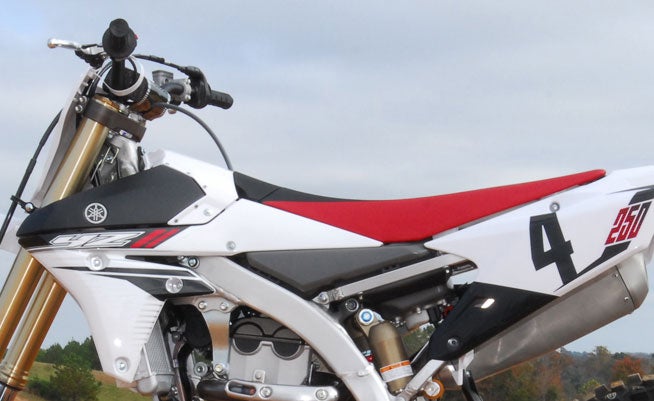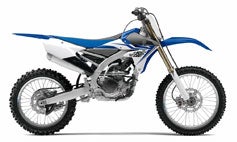Chassis
No one ever complained about the handling character of the 2013 YZ250F, but since there was no way to fit the new engine in the old chassis, Yamaha engineers swapped it out for an all-new aluminum bilateral beam design that features the exact same rake and trail figures as the 2013 but is 14mm narrower at its widest point to give the 2014 model a slimmer and more compact feel. In fact, this same chassis is also used on the 2014 YZ450F—only the motor mounts distinguish the two. Since the 250F now uses the same engine configuration as its big sister, it follows that its mass-centralizing theme also includes a wraparound head pipe and a more compact muffler that’s repositioned 186mm further forward behind the side panel and lower and closer to the middle of the chassis. The 2014 250F’s half-gallon larger, 2.1-gallon fuel tank is also rearward and lower in the chassis., and the fuel filler is now located below the frame spars. Refueling is accomplished by removing the forward section of the seat to access the recessed fuel cap.

We were fans of the YZ250F’s cornering prowess when we rode it at Glen Helen, and nothing at Monster Mountain has changed our minds. The 2014 model turns in with precision and holds its line through corners with authority. Monster Mountain’s red clay tended to form long, deep ruts in the corners, but the 250F hunkered down and handled them with ease. At the same time, we never experienced a hint of headshake on the YZ250F, and can’t say that about the 2914 YZ450F. The YZ250F delivers intuitive cornering and rock-solid stability in wet or dry conditions, on loose or tight racetracks, in any corner or over any jump. Can it even be more awesome?

Suspension
During the YZ250F technical presentation on the first night, Yamaha’s crew received a round of applause when it reconfirmed that the YZ250F’s fork still incorporates one coil spring and one cartridge per fork leg rather than using one spring for both legs, or even compressed air in lieu of coil springs. That’s because the word has already begun to circulate that the air forks in particular require more maintenance and don’t deliver the consistent damping over long motos like their designers had intended. By sticking with a tried-and-true fork design, Yamaha sidesteps any controversy.
Not that the KYB fork doesn’t feature impressive technology. Just proven technology. Its Speed Sensitive valving system, which uses piston speed to control the damping, delivers very good performance over a wide range of conditions. We noticed a slight harshness initially, but the more we rode the bike the less of an issue it became. The fork worked in perfect harmony with the fully adjustable KYB shock mated to the YZ’s aluminum swingarm and rising-rate shock linkage. The rear end tracked straight and true through all of the bumps at Monster Mountain, same as it had at Glen Helen, again without requiring us to do any more than set the rear sag to find happiness.
Brakes/Tires
The YZ250F’s wave rotor disc brakes are about the only thing that isn’t new on the 2014 model, and that’s just fine as the two-piston-clamped the 250mm front disc and single-piston 245mm rear are more than capable of slowing the 250’s claimed 231-lbs. with authority. Both the front and the rear serve up strong stopping power without feeling overly sensitive regardless of terrain. Of course, we also have to give some credit to the stock Bridgestone M404-A front and M403 rear tires, which exhibit a consistent feel on hard or soft riding conditions.
Ergonomics/Styling
The absence of a gas cap on top the YZ250F’s tank allows the rider to move forward on its slim seat without fear of catching one’s “self,” thus adding to its cornering confidence, and although the 2014 model features larger capacity radiators to increase cooling, they are tucked in nicely to eliminate the chance of catching a boot on the radiator shrouds during hard cornering. We liked the handlebar just as it was set in its stock position, but the bar can be adjusted to any of four positions to facilitate rider size and/or comfort. The bars are also rubber-mounted atop the YZ’s new, more rigid triple clamp to minimize vibration through the rider’s hands. Overall, we are very pleased with the ergonomics.

Our Monster Mountain test unit also featured Yamaha’s optional white/red/black graphics scheme with black rims for added sex appeal. And the graphics should stay good-looking for a long time, thanks to a new process by which they are embedded into the plastic, making them impossible to peel off and more resistant to scratches.
With all of the work that went into making the 2014 Yamaha YZ250F a more capable motocrosser, we find it hard to believe that the new model commands only $200 more than the old one. For $7490, you’ll have to go a long way to find a 250cc four-stroke that packs more power and better handling than the YZ does, but that’s what shootouts are for. Based on its engine performance alone, we’re confident that the YZ will be a tough contender, and we won’t be surprised if it regains the top spot in the class. This is one badass 250.
2014 Yamaha YZ250F Specifications
MSRP: $7490
Engine: Liquid-cooled four-stroke single, DOHC four-valve head
Displacement: 249cc
Bore x stroke: 77.0 x 53.6mm
Horsepower: 40 rwhp (claimed)
Torque: N/A
Compression ratio: 13.5:1
Fuel System: Keihin EFI, 44m throttle body
Ignition: TCI
Transmission: Five-speed
Final drive: Chain
Frame type: Bilateral beam aluminum
Front suspension: Inverted KYB fully adj. fork w/Speed Sensitive System; 12.2 in. of travel
Rear suspension: KYB fully adjustable monoshock w/piggyback reservoir, 50mm piston; 12.4 in. of travel
Front brake: Nissin two-piston caliper 250mm wave-style disc
Rear brake: Nissin single-piston caliper 245mm wave-style disc
Front tire: Bridgestone M404-A 80/100-21
Rear tire: Bridgestone M403 100/90-19
Wheelbase: 58.1 in.
Rake/trail: N/A
Seat height: 38.0 in.
Ground clearance: 12.8 in.
Wet Weight: 231 lbs. (claimed)
Fuel capacity 2.1 gal.
Color choices: Blue & White / White Red & Black
 Your Privacy Choices
Your Privacy Choices